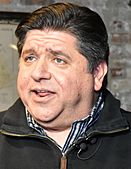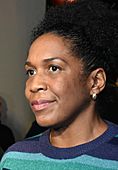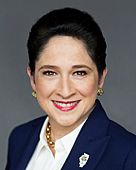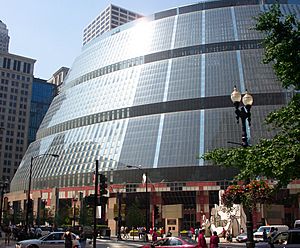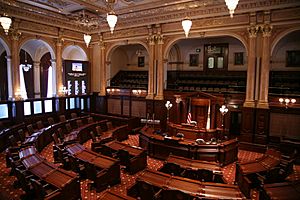Government of Illinois facts for kids
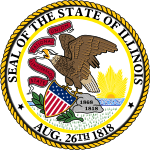
|
|
| Part of | United States of America |
|---|---|
| Constitution | Constitution of Illinois |
| Legislative branch | |
| Name | Legislature |
| Type | Bicameral |
| Meeting place | Illinois General Assembly |
| Upper house | |
| Name | Senate |
| Presiding officer | Don Harmon, President |
| Lower house | |
| Name | House of Representatives |
| Presiding officer | Emanuel Chris Welch, Speaker |
| Executive branch | |
| Head of State and Government | |
| Title | Governor |
| Currently | J. B. Pritzker |
| Appointer | Election |
| Cabinet | |
| Name | Cabinet |
| Leader | Governor |
| Deputy leader | Lieutenant Governor |
| Headquarters | Illinois State Capitol |
| Judicial branch | |
| Name | Judiciary of Illinois |
| Courts | Courts of Illinois |
| Supreme Court of Illinois | |
| Chief judge | Mary Jane Theis |
| Seat | Springfield, Illinois |
The Government of Illinois works to serve the people of the state. It is set up by the Constitution of Illinois. Just like the United States government, Illinois has three main parts, called branches. These branches are the Executive, Legislative, and Judicial. Each branch has different jobs to make sure the state runs smoothly.
The Executive branch is led by the Governor. This branch carries out the laws. The Legislative branch, called the General Assembly, makes the laws. It has two parts: the House of Representatives and the Senate. The Judicial branch, which includes the Supreme Court of Illinois and other courts, interprets the laws.
Contents
Executive Branch: Leading the State
The executive branch is in charge of putting state laws into action. It has six main elected leaders. Illinois is one of many states where the Governor and Lieutenant Governor are elected together.
The six main elected officers are:
-
Alexi Giannoulias (D)
Secretary of State
State Departments: Helping Illinoisans
The government of Illinois has many departments and agencies. These groups help provide important services to people across the state. They are often called "code departments" because they are set up by state laws.
Some of these important departments include:
- Department on Aging: Helps older adults.
- Department of Agriculture: Supports farming and food production.
- Department of Central Management Services: Manages state property and services.
- Department of Children and Family Services: Protects children and supports families.
- Department of Commerce and Economic Opportunity: Works to improve the state's economy.
- Department of Corrections: Manages prisons and correctional facilities.
- Emergency Management Agency: Prepares for and responds to emergencies.
- Department of Employment Security: Helps people find jobs and provides unemployment benefits.
- Department of Financial and Professional Regulation: Oversees financial and professional licenses.
- Department of Healthcare and Family Services: Provides healthcare assistance.
- Department of Human Rights: Protects people's civil rights.
- Department of Human Services: Offers social services to those in need.
- Department of Juvenile Justice: Works with young people in the justice system.
- Department of Labor: Protects workers' rights and safety.
- Department of the Lottery: Manages the state lottery.
- Department of Natural Resources: Protects natural areas and wildlife.
- Department of Public Health: Works to keep people healthy.
- Department of Revenue: Collects state taxes.
- Department of State Police: Enforces state laws and ensures public safety.
- Department of Transportation: Manages roads, bridges, and transportation.
- Department of Veterans' Affairs: Supports military veterans.
Legislative Branch: Making State Laws
The Illinois General Assembly is the part of the government that makes laws for Illinois. It has two main parts:
- The Illinois House of Representatives: This part has 118 members.
- The Illinois Senate: This part has 59 members.
Members of the House choose a Speaker to lead them. Senators choose a President of the Senate.
The Governor can say "no" to a bill, which is called a veto. There are different kinds of vetoes. However, the General Assembly can still make a bill a law even if the Governor vetoes it. This happens if three-fifths of the members in both the House and the Senate vote to override the veto.
Judicial Branch: Interpreting Laws

The judicial branch is made up of courts that explain and apply the laws.
Supreme Court of Illinois
The Supreme Court is the highest court in the state. It mostly hears appeals from lower courts. It must hear cases about the death penalty and cases where a law's fairness under the constitution is questioned. It can also choose to hear other important cases.
Appellate Court of Illinois
The Appellate Court is the first place to appeal a decision from a trial court. It reviews cases involving disagreements between people (civil cases) and cases about crimes (criminal cases).
Circuit Courts of Illinois
The circuit courts are the main trial courts. This is where most cases start. Illinois has 25 judicial circuits. Each circuit covers one or more of the state's 102 counties. These courts can hear almost any kind of case, from small claims to serious crimes.
State Capital: Springfield and Chicago's Role
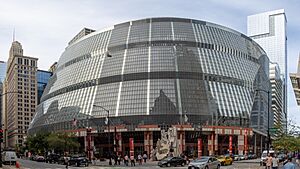
Springfield is the official capital city of Illinois. Many state offices are located there. It is also where the Illinois General Assembly regularly meets to make laws. State law requires that all statewide elected officials have at least one home in Springfield, paid for by the state.
However, many state leaders also do a lot of their work in Chicago. Some people say that Chicago acts like a "second capital" because so many important state activities happen there. For example, many cabinet members and elected officials have offices in Chicago. Some people believe that spending less time in Springfield can make officials feel less connected to the state employees who work there.
In 2007, a state representative named Raymond Poe suggested ending state funding for officials' travel to Springfield. He believed that Springfield should be their main workplace.
Local Government: Serving Communities
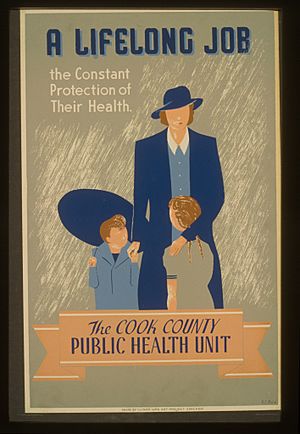
Illinois has many different types of local governments. These include counties, townships, cities, towns, villages, and special districts. Illinois has more local government units than any other state, over 8,000 in total!
The state is divided into 102 counties. Most counties are also divided into smaller areas called townships. Cities, villages, and incorporated towns have their own local governments. Some of these local areas have "home rule." This means they have more power to make their own local laws and decisions.
Local governments in Illinois can create their own rules, called local ordinances. Illinois also has different types of school districts, like the Chicago Public Schools. There are also other government units that manage things like parks, libraries, or fire services.
See also
- Elections in Illinois
- Illinois Budget Impasse
- Law enforcement in Illinois
- Law of Illinois
- Politics of Illinois


